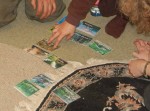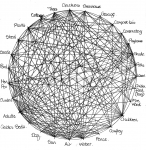by Aranya
Introduction
So having identified the key functions that we are going to design for, we are now going to think about the best ways to fulfil them. Ideally, we only include something (a system or element) in our design if it fulfils at least three functions. Remember the ecological principle: Multiple functions for each element. Nature happens to be so productive, because everything performs many functions.
The process
Taking each of your chosen functions in turn, write down all the ways you can think of to (realistically) achieve them. Obviously disregard anything that is clearly way beyond budget, or an inappropriate scale (too big or small) for the purpose. When you are done you should have three or four lists, one for each function. You will probably find that some of the things you thought of are on several of your lists. Go through them again and see which other of the systems and elements you thought of also perform any of the other functions. This identifies some strong possibilities, though you will still have to make sure that they are suited to the site conditions and other client requirements (do they fit in with the client’s values?) before deciding upon including them in your design. Here are some criteria that you may find useful in choosing the best systems and elements to go in your design:
1. The permaculture ethics How do the systems and elements you are considering perform against the three ethics:
- Care of the Earth – rebuilding natural capital – soil, forests, clean air and water, species diversity etc.
- Care of people – physical, emotional, spiritual – yourself, your family,community, culture & humanity as a whole.
- Fair shares – of surpluses, and voluntary limits to consumption and reproduction – equality leading to peaceful planetary co-habitation.
2. What is the footprint of each possibility? Some of your options may have a much greater ecological footprint than others. Some may have a clearly greater embodied energy (EMERGY) – the energy required to create it and dispose safely of it at the end of its useful life. It is not necessary to know exactly how much energy is required at each stage, just take a good guess. That will be enough to help you make your choices. Biological (natural) resources tend to be the best choices to include in our designs, as they are usually renewable and can be safely disposed of without poisoning the Earth.
3. What does each option offer? A couple of useful thinking tools you can use to compare your possible choices are the SWOC and PMI tools. SWOC stands for:
- Strengths - what are the good things about choosing this?
- Weaknesses – what are the not so good things about this?
- Opportunities – what will this allow me to do?
- Constraints – what constraints will this choice place on other options?
For instance, you might decide that for a windbreak, a hedge would offer you a solution that gets bigger over time (S), but takes a while to establish (W), it could offer additional outputs like wildlife habitats and food / fodder (O), but create shade and competition for other plants growing on the north* side of it (C). A wooden fence might provide a fairly instant barrier (S), but need more maintaining (W), provide a good vertical structure for climbing plants (O), but involve damaging those climbers when maintenance takes place. *In the northern hemisphere. Or in a similar vein ~ PMI stands for:
- Pluses – what are the good things
- Minuses – what are the not so good things?
- Interesting things – what else might be relevant, even though they may be
- neither good nor bad?
Having applied either of these tools to your different options, you can compare them all & choose those that seem to offer the most potential.
4. How could they integrate with other systems & elements in your design?
By identifying the needs (inputs) and outputs of each system or element, you can see where beneficial relationships can be created. If you can place two elements together so that the outputs of one feed the needs of another, you are on the way to creating a self-sustaining system. The more you can do this, the less work will be required to maintain the overall system you design. Two good tools to help you with this process are ‘random assembly’ and the ‘web of connections’.
Random assembly Write down each of your elements (or systems) on separate pieces of paper or card. Stack them into a pile, turn it face down, shuffle them and cut into two piles. Turn over the top card from each pile and see whether you can think of any connections between the two systems / elements. This process can help you to identify connections that a quick consideration might not identify. Write down any particularly good connections, or any elements that you think you need to keep well apart.
Using random assembly to identify possible beneficial connections
Web of connections This is a more thorough version of the above, for those of us who like to consider all options. Draw a large circle & write each of the elements around the outside of the circle. Choosing each in turn, go around the circle & identify where connections can made. As you find them, draw a line joining them together. Again, for any really good connections, make a special note to remind you later.
5. Diversity Multiple elements for each important function. Ensure that there is a diversity of elements in your design, providing security – especially for important functions like food, water, energy etc. If all your energy is supplied by one source (e.g. mains electricity) & that source stops working, then you are in trouble. If you don’t have multiple options, you are very vulnerable. 6. Efficiency Multiple functions for each element. Choosing elements and systems that are multifunctional, builds in extra efficiency (& in turn more yields) to your design. The more functions you build in, the more effective your design. Your challenge is to design & establish a system where the energy needed to maintain it reduces over time, while the outputs from the system increase. A target to aim for is to spend around 80% of your time / energy in establishing it, so you only have to spend 20% in maintaining it.
Placing everything
So having determined the best systems & elements for your design, we can now think about where best to place them all (part 6). Go to part 6 - Placement & Integration
- Log in to post comments


